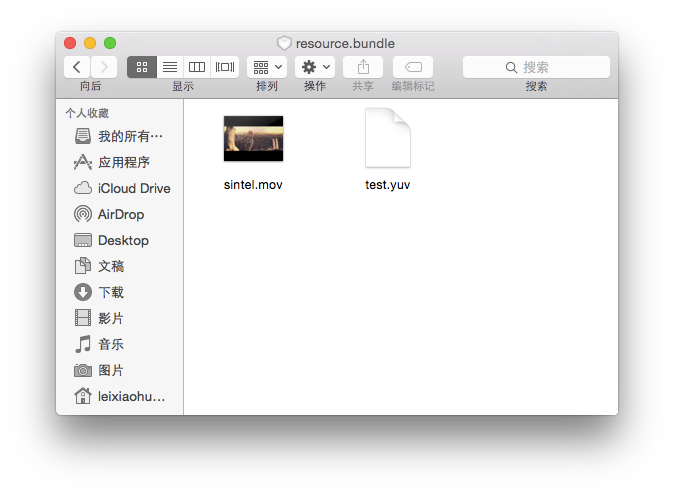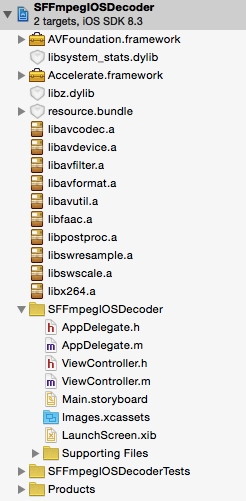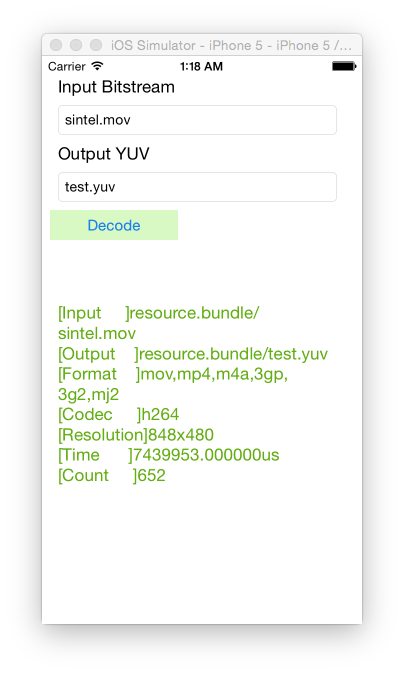最简单的基于FFmpeg的直播系统开发移动端例子:IOS 视频解码器
本文记录IOS平台下基于FFmpeg的视频解码器。该示例C语言的源代码来自于《最简单的基于FFMPEG+SDL的视频播放器》。相关的概念就不再重复记录了。
源代码
项目的目录结构如图所示。
C代码位于ViewController.m文件中,内容如下所示。
- /**
- * 最简单的基于FFmpeg的视频解码器-IOS
- * Simplest FFmpeg IOS Decoder
- *
- * 雷霄骅 Lei Xiaohua
- * leixiaohua1020@126.com
- * 中国传媒大学/数字电视技术
- * Communication University of China / Digital TV Technology
- * http://blog.csdn.net/leixiaohua1020
- *
- * 本程序是IOS平台下最简单的基于FFmpeg的视频解码器。
- * 它可以将输入的视频数据解码成YUV像素数据。
- *
- * This software is the simplest decoder based on FFmpeg in IOS.
- * It can decode video stream to raw YUV data.
- *
- */
- #import "ViewController.h"
- #include <libavcodec/avcodec.h>
- #include <libavformat/avformat.h>
- #include <libavutil/imgutils.h>
- #include <libswscale/swscale.h>
- @interface ViewController ()
- @end
- @implementation ViewController
- - (void)viewDidLoad {
- [super viewDidLoad];
- // Do any additional setup after loading the view, typically from a nib.
- }
- - (void)didReceiveMemoryWarning {
- [super didReceiveMemoryWarning];
- // Dispose of any resources that can be recreated.
- }
- - (IBAction)clickDecodeButton:(id)sender {
- AVFormatContext *pFormatCtx;
- int i, videoindex;
- AVCodecContext *pCodecCtx;
- AVCodec *pCodec;
- AVFrame *pFrame,*pFrameYUV;
- uint8_t *out_buffer;
- AVPacket *packet;
- int y_size;
- int ret, got_picture;
- struct SwsContext *img_convert_ctx;
- FILE *fp_yuv;
- int frame_cnt;
- clock_t time_start, time_finish;
- double time_duration = 0.0;
- char input_str_full[500]={0};
- char output_str_full[500]={0};
- char info[1000]={0};
- NSString *input_str= [NSString stringWithFormat:@"resource.bundle/%@",self.inputurl.text];
- NSString *output_str= [NSString stringWithFormat:@"resource.bundle/%@",self.outputurl.text];
- NSString *input_nsstr=[[[NSBundle mainBundle]resourcePath] stringByAppendingPathComponent:input_str];
- NSString *output_nsstr=[[[NSBundle mainBundle]resourcePath] stringByAppendingPathComponent:output_str];
- sprintf(input_str_full,"%s",[input_nsstr UTF8String]);
- sprintf(output_str_full,"%s",[output_nsstr UTF8String]);
- printf("Input Path:%s\n",input_str_full);
- printf("Output Path:%s\n",output_str_full);
- av_register_all();
- avformat_network_init();
- pFormatCtx = avformat_alloc_context();
- if(avformat_open_input(&pFormatCtx,input_str_full,NULL,NULL)!=0){
- printf("Couldn't open input stream.\n");
- return ;
- }
- if(avformat_find_stream_info(pFormatCtx,NULL)<0){
- printf("Couldn't find stream information.\n");
- return;
- }
- videoindex=-1;
- for(i=0; i<pFormatCtx->nb_streams; i++)
- if(pFormatCtx->streams[i]->codec->codec_type==AVMEDIA_TYPE_VIDEO){
- videoindex=i;
- break;
- }
- if(videoindex==-1){
- printf("Couldn't find a video stream.\n");
- return;
- }
- pCodecCtx=pFormatCtx->streams[videoindex]->codec;
- pCodec=avcodec_find_decoder(pCodecCtx->codec_id);
- if(pCodec==NULL){
- printf("Couldn't find Codec.\n");
- return;
- }
- if(avcodec_open2(pCodecCtx, pCodec,NULL)<0){
- printf("Couldn't open codec.\n");
- return;
- }
- pFrame=av_frame_alloc();
- pFrameYUV=av_frame_alloc();
- out_buffer=(unsigned char *)av_malloc(av_image_get_buffer_size(AV_PIX_FMT_YUV420P, pCodecCtx->width, pCodecCtx->height,1));
- av_image_fill_arrays(pFrameYUV->data, pFrameYUV->linesize,out_buffer,
- AV_PIX_FMT_YUV420P,pCodecCtx->width, pCodecCtx->height,1);
- packet=(AVPacket *)av_malloc(sizeof(AVPacket));
- img_convert_ctx = sws_getContext(pCodecCtx->width, pCodecCtx->height, pCodecCtx->pix_fmt,
- pCodecCtx->width, pCodecCtx->height, AV_PIX_FMT_YUV420P, SWS_BICUBIC, NULL, NULL, NULL);
- sprintf(info, "[Input ]%s\n", [input_str UTF8String]);
- sprintf(info, "%s[Output ]%s\n",info,[output_str UTF8String]);
- sprintf(info, "%s[Format ]%s\n",info, pFormatCtx->iformat->name);
- sprintf(info, "%s[Codec ]%s\n",info, pCodecCtx->codec->name);
- sprintf(info, "%s[Resolution]%dx%d\n",info, pCodecCtx->width,pCodecCtx->height);
- fp_yuv=fopen(output_str_full,"wb+");
- if(fp_yuv==NULL){
- printf("Cannot open output file.\n");
- return;
- }
- frame_cnt=0;
- time_start = clock();
- while(av_read_frame(pFormatCtx, packet)>=0){
- if(packet->stream_index==videoindex){
- ret = avcodec_decode_video2(pCodecCtx, pFrame, &got_picture, packet);
- if(ret < 0){
- printf("Decode Error.\n");
- return;
- }
- if(got_picture){
- sws_scale(img_convert_ctx, (const uint8_t* const*)pFrame->data, pFrame->linesize, 0, pCodecCtx->height,
- pFrameYUV->data, pFrameYUV->linesize);
- y_size=pCodecCtx->width*pCodecCtx->height;
- fwrite(pFrameYUV->data[0],1,y_size,fp_yuv); //Y
- fwrite(pFrameYUV->data[1],1,y_size/4,fp_yuv); //U
- fwrite(pFrameYUV->data[2],1,y_size/4,fp_yuv); //V
- //Output info
- char pictype_str[10]={0};
- switch(pFrame->pict_type){
- case AV_PICTURE_TYPE_I:sprintf(pictype_str,"I");break;
- case AV_PICTURE_TYPE_P:sprintf(pictype_str,"P");break;
- case AV_PICTURE_TYPE_B:sprintf(pictype_str,"B");break;
- default:sprintf(pictype_str,"Other");break;
- }
- printf("Frame Index: %5d. Type:%s\n",frame_cnt,pictype_str);
- frame_cnt++;
- }
- }
- av_free_packet(packet);
- }
- //flush decoder
- //FIX: Flush Frames remained in Codec
- while (1) {
- ret = avcodec_decode_video2(pCodecCtx, pFrame, &got_picture, packet);
- if (ret < 0)
- break;
- if (!got_picture)
- break;
- sws_scale(img_convert_ctx, (const uint8_t* const*)pFrame->data, pFrame->linesize, 0, pCodecCtx->height,
- pFrameYUV->data, pFrameYUV->linesize);
- int y_size=pCodecCtx->width*pCodecCtx->height;
- fwrite(pFrameYUV->data[0],1,y_size,fp_yuv); //Y
- fwrite(pFrameYUV->data[1],1,y_size/4,fp_yuv); //U
- fwrite(pFrameYUV->data[2],1,y_size/4,fp_yuv); //V
- //Output info
- char pictype_str[10]={0};
- switch(pFrame->pict_type){
- case AV_PICTURE_TYPE_I:sprintf(pictype_str,"I");break;
- case AV_PICTURE_TYPE_P:sprintf(pictype_str,"P");break;
- case AV_PICTURE_TYPE_B:sprintf(pictype_str,"B");break;
- default:sprintf(pictype_str,"Other");break;
- }
- printf("Frame Index: %5d. Type:%s\n",frame_cnt,pictype_str);
- frame_cnt++;
- }
- time_finish = clock();
- time_duration=(double)(time_finish - time_start);
- sprintf(info, "%s[Time ]%fus\n",info,time_duration);
- sprintf(info, "%s[Count ]%d\n",info,frame_cnt);
- sws_freeContext(img_convert_ctx);
- fclose(fp_yuv);
- av_frame_free(&pFrameYUV);
- av_frame_free(&pFrame);
- avcodec_close(pCodecCtx);
- avformat_close_input(&pFormatCtx);
- NSString * info_ns = [NSString stringWithFormat:@"%s", info];
- self.infomation.text=info_ns;
- }
- @end
运行结果
App在手机上运行后的结果如下图所示。单击“Decode”,将会把位于resource.bundle中的“sintel.mov”文件解码为“sintel.yuv”文件并存储于相同的目录下。
生成的文件如下图所示。

本文转载自网络,感谢原作者的分享,转载仅为分享干货知识,如有侵权欢迎联系作者进行删除处理。
最简单的基于FFmpeg的直播系统开发移动端例子:IOS 视频解码器的更多相关文章
- 简单red5+obs推流实现直播系统开发,具体设置介绍
前言:随便搞搞,先放一张效果图,
- 最简单的基于FFmpeg的内存读写的例子:内存播放器
===================================================== 最简单的基于FFmpeg的内存读写的例子系列文章列表: 最简单的基于FFmpeg的内存读写的 ...
- (转)最简单的基于FFmpeg的内存读写的例子:内存播放器
ffmpeg内存播放解码 目录(?)[+] ===================================================== 最简单的基于FFmpeg的内存读写的例子系列文章 ...
- 最简单的基于FFmpeg的推流器(以推送RTMP为例)
===================================================== 最简单的基于FFmpeg的推流器系列文章列表: <最简单的基于FFmpeg的推流器(以 ...
- 最简单的基于FFmpeg的AVDevice例子(屏幕录制)
=====================================================最简单的基于FFmpeg的AVDevice例子文章列表: 最简单的基于FFmpeg的AVDev ...
- 最简单的基于FFmpeg的AVDevice例子(读取摄像头)
=====================================================最简单的基于FFmpeg的AVDevice例子文章列表: 最简单的基于FFmpeg的AVDev ...
- [转载] 最简单的基于FFmpeg的AVDevice例子(读取摄像头)
=====================================================最简单的基于FFmpeg的AVDevice例子文章列表: 最简单的基于FFmpeg的AVDev ...
- 100行代码实现最简单的基于FFMPEG+SDL的视频播放器(SDL1.x)【转】
转自:http://blog.csdn.net/leixiaohua1020/article/details/8652605 版权声明:本文为博主原创文章,未经博主允许不得转载. 目录(?)[-] ...
- 最简单的基于FFmpeg的AVDevice例子(读取摄像头)【转】
转自:http://blog.csdn.net/leixiaohua1020/article/details/39702113 版权声明:本文为博主原创文章,未经博主允许不得转载. 目录(?)[- ...
随机推荐
- Python实现的数据结构与算法之链表详解
一.概述 链表(linked list)是一组数据项的集合,其中每个数据项都是一个节点的一部分,每个节点还包含指向下一个节点的链接.根据结构的不同,链表可以分为单向链表.单向循环链表.双向链表.双向循 ...
- java高级项目 jdbc与数据库连接数据库
//图书管类 public class Book { private Integer id; private String b_name; private double b_price; privat ...
- js获取foreach循环选中的值
一,循环出来的值,通过checked选中,获取到value值 二,定义一个空数组,用push将数据保存在数组里面 以上操作便可以进行虎丘选中的值了
- Go strconv包
strconv包 该包主要实现基本数据类型与其字符串表示的转换. 常用函数为Atoi().Itia().parse系列.format系列.append系列. 更多函数请查看官方文档. string与i ...
- 从源码角度来分析线程池-ThreadPoolExecutor实现原理
作为一名Java开发工程师,想必性能问题是不可避免的.通常,在遇到性能瓶颈时第一时间肯定会想到利用缓存来解决问题,然而缓存虽好用,但也并非万能,某些场景依然无法覆盖.比如:需要实时.多次调用第三方AP ...
- 发布MeteoInfo 1.2.3
提升了对GeoTiff格式数据的读取能力(多个tiles).当然还有MeteoInfoLab功能的提升.下载地址:http://yun.baidu.com/share/link?shareid=669 ...
- ansible使用playbook的简单例子(ansible2.9.7)
一,ansible使用playbook的优点 1,用ansible执行一些简单的任务,使用ad-hoc命令就可以解决问题 如果执行复杂的功能,需要大量的操作,执行的ad-hoc命令会不够方便,这时我们 ...
- centos8平台用ss监控网络
一,ss所属的包: [root@blog ~]# whereis ss ss: /usr/sbin/ss /usr/share/man/man8/ss.8.gz [root@blog ~]# rpm ...
- win安装appium
Windows 下配置 Appium,要提前装好jdk,请参考:https://jingyan.baidu.com/article/e8cdb32b2699cb37042bad59.html 1.下载 ...
- HTML <del> 标签
HTML <del> 标签 什么是<del> 标签? 定义文档中已被删除的文本. 实例 a month is <del>25</del> 30 day ...



